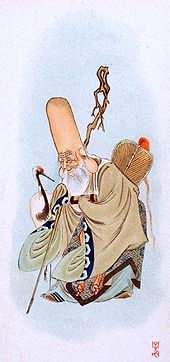Fukurokuju



In Japan, Fukurokuju (福禄寿; from Japanese fuku, "happiness"; roku, "wealth"; and ju, "longevity") is one of the Seven Lucky Gods in Japanese mythology.[1] It has been theorized that he is a Japanese assimilation of the Chinese Three Star Gods (Fu Lu Shou) embodied in one deity. Most related in appearance to the Chinese star god Shou, he is the God of wisdom and longevity.[2] According to some, before attaining divinity, he was a Chinese hermit of the Song dynasty and a reincarnation of the Taoist Deity, Xuantian Shangdi. It is said that during his human incarnation, he was a sennin; a immortal who could exist without eating food.
Fukurokuju probably originated from an old Chinese tale about a mythical Chinese Taoist hermit sage renowned for performing miracles in the Northern Song period (960–1127). In China, this hermit (also known as Jurōjin) was thought to embody the celestial powers of the south polar star. Fukurokuju was not always included in the earliest representations of the Seven in Japan. He was instead replaced by Kisshōten (goddess of fortune, beauty, and merit). He is now, however, an established member of the Seven Lucky Gods.[3]
He is sometimes confused with Jurōjin, another of the Several Gods of Fortune, who by some accounts is Fukurokuju's grandson and by other accounts inhabits the same body as Fukurokuju.[4] As such, the two are often confused.[5]
Fukurokuju is usually portrayed as bald with long whiskers and an elongated forehead.[1] He is said to be an incarnation of the "Southern Polestar" (南极老人, literally Old Man of the South Pole), also known as the star Canopus outside of Asia. The sacred book tied to his staff either contains the lifespan of every person on earth or a magical scripture. He is accompanied by a crane and a turtle, which are considered to be symbols of longevity. He is also sometimes accompanied by a black deer (ancient legends say a deer turns black if it is over 2000 years old).

He is the only member of the Seven Lucky Gods credited with the ability to resurrect the dead.
See also
[edit]References
[edit]- ^ a b Goldberg, Joshua (24 April 2009). "In praise of darkness: the 'Hands-on Japan' exhibition". Museum International. 33 (3): 187–193. doi:10.1111/j.1468-0033.1981.tb01961.x.
- ^ Davis, F. Hadland (1912). Myths and Legends of Japan (PDF). London: George G. Harrap & Company. p. 388. Archived from the original (PDF) on 12 April 2020. Retrieved 18 April 2020.
- ^ Sykes, Egerton (1993). Kendall, Alan (ed.). Who's Who in Non-Classical Mythology. New York: Oxford University Press, Inc. p. 73.
- ^ Graham, Patricia (2007). Faith and Power in Japanese Buddhist Art, 1600-2005. University of Hawaii Press. p. 110. ISBN 978-0-8248-3126-4.
- ^ "寿老人" [Jurōjin]. Nihon Daihyakka Zensho (Nipponika) (in Japanese). Tokyo: Shogakukan. 2013. OCLC 153301537. Archived from the original on 25 August 2007. Retrieved 12 January 2013.
Bibliography
[edit] Media related to Fukurokuju at Wikimedia Commons
Media related to Fukurokuju at Wikimedia Commons
- Ashkenazi, Michael (2003). Handbook of Japanese Mythology. Santa Barbara, California: ABC-CLIO. ISBN 978-1-57607-467-1.
- Chiba, Reiko (28 August 2012). Seven Lucky Gods of Japan. Tuttle Publishing. ISBN 978-1-4629-0420-4.


